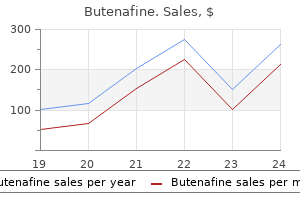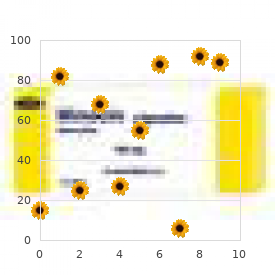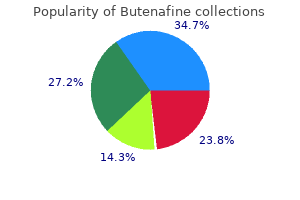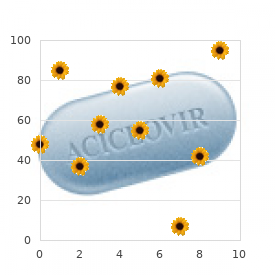Only $18.88 per item
Butenafine dosages: 15 mg
Butenafine packs: 1 tubes, 2 tubes, 3 tubes, 4 tubes, 5 tubes, 6 tubes, 7 tubes, 8 tubes, 9 tubes, 10 tubes
In stock: 831
10 of 10
Votes: 76 votes
Total customer reviews: 76
Description
The shock waves can also inhibit pacemaker output when administered asynchronously antifungal examples generic 15 mg butenafine with mastercard. Therefore, if a magnet is used to turn off the defibrillator, the anesthesiologist and surgeon must take the following in to account. Therefore, the surgeon should either limit electrocautery bursts to less than 5 s or use a bipolar electrode. Optimal position may be an important factor in the prevention of adverse outcomes [59, 61]. This specific scenario requires coordination between the anesthesiologist and cardiologist. They are designed with a high-frequency noise filter to prevent malfunction from the energy interference [106108]. However, electromagnetic interference is an important cause of pacemaker malfunction. In an emergency, a magnet can be placed over a standalone pacemaker to convert it to an asynchronous mode. However, the use of a magnet should be discouraged whenever there is adequate time to properly interrogate a pacemaker before and after surgery. After the surgical procedure is completed, pacemakers should be interrogated to be sure they have retained the desired settings. However, Anesthesia for ureteroscopy With the advent of smaller and semi-rigid flexible ureteroscopes, intravenous sedation is favorable for cases of short duration such as cystoscopy and stent insertion. Ureteral stents, renal calculi, and ureteral strictures have been successfully performed using lidocaine 4% gel to anesthetize the urethra. This anesthetic technique has the benefit of faster operating room turnover and faster discharge from hospital [110116]. Among men, discomfort during rigid ureteroscopy seems to be related to the passage of the instrument through the membranous Chapter 60 Anesthesia for the Endourologic Management of Stone Disease 697 urethra and bladder neck [110]. Pain seems to be better tolerated in women having the procedure under local or intravenous sedation [95]. Due to the fact that the kidneys normally move with the respiratory cycle, the stone is only intermittently visualized [46, 47]. It is imperative that the anesthesiologist and urologist work together to allow concomitant adequate ventilation and intermittent apneic episodes to successfully fragment stones. Urethral trauma with patient movement is a concern during ureteroscopy, emphasizing the importance of selecting an appropriate anesthetic technique for a given patient. If a patient experiences sudden movements under anesthesia with a ureteroscope in use, there is the potential for ureteral trauma or ureteral transection, a potentially devastating and avoidable complication. Selection of anesthetic agent may be tailored to the fact that most of these procedures are performed on an outpatient basis and the patient will be going home on the day of the procedure. However, regardless of the choice of anesthetic technique, it is imperative that the anesthesiologist be vigilant that the patient is adequately anesthetized to avoid such complication. The urethra receives innervation from the preganglionic sympathetic fibers of the T10L2 spinal segments.

Monarda didyma (Oswego Tea). Butenafine.
- What is Oswego Tea?
- How does Oswego Tea work?
- Dosing considerations for Oswego Tea.
- Are there safety concerns?
- Digestion disorders, gas, premenstrual syndrome (PMS), spasms, fluid retention, fever, and other conditions.
Source: http://www.rxlist.com/script/main/art.asp?articlekey=96206
The safety of ureteroscopy during pregnancy: a systematic review and metaanalysis zeta antifungal discount butenafine 15 mg amex. Rigid ureteroscopy for diagnosis and treatment of ureteral calculi during pregnancy. Ureteroscopy and holmium laser lithotripsy in pregnancy: stents must be used postoperatively. Flexible ureteroscopy: an extended approach to different urological problems in pregnancy. Non-medical management of urinary tract stones during pregnancy - 5 year experience. Semirigid ureteroscopy and pneumatic lithotripsy as definitive management of obstructive ureteral calculi during pregnancy. Diagnosis and treatment of ureteral calculi during pregnancy with rigid ureteroscopes. Measurement of sound emission by ultrasonic lithotripters: an in vitro study and theoretical estimation of risk of hearing loss in a fetus. Additionally, large population-based studies have shown that obesity and weight gain increase risk of kidney stone formation due to alterations in urinary metabolite excretion in adults [3, 4]. In an interviewbased study of patients with urolithiais, the prevalence of obesity was 17. The management of obese stone formers is now safer and more successful thanks to advances in minimally invasive techniques and improvements in anesthesia, but these patients still present some specific technical challenges which the urologist needs to be aware of to provide optimum care. Hyperinsulinemia, insulin resistance, and gout diathesis may be factors that lower urinary pH in obesity. Hyperinsulinemia Obese patients have a higher incidence of diabetes mellitus, which correlates with hyperinsulinemia or insulin resistance. Insulin is known to stimulate the synthesis of ammonia and sodiumhydrogen exchange in the renal tubule, which mediates ammonium excretion in urine. Hyperinsulinemia-associated obesity contributes to the development of calcium stones by decreasing urinary citrate and increasing urinary excretion of calcium, uric acid, and oxalate [8]. Insulin resistance may result in defective ammonium production and the ability to excrete acid, thus lowering urine pH. Obesity and stone risk Studies have shown that the most common stone component in obese patients is calcium oxalate and they have a slightly higher incidence of uric acid stones as well [4, 6]. In addition, these studies suggest that obesity is strongly associated with an increased risk of stone episodes. Metabolites High metabolic load is another important factor for urolithiasis in obesity. Taylor and Curhan reported that obese male patients excreted more urinary oxalate, calcium, uric acid, sodium, and phosphate than nonobese patients, as did obese women patients, although increased urinary calcium was seen only in younger women.

Specifications/Details
These lesions may also have a slightly indistinct interface with the adjacent renal parenchyma [3438] antifungal cream boots order 15 mg butenafine fast delivery. Stability over time suggests these lesions are benign, recognizing that some malignant lesions can grow slowly and that cysts can enlarge. Therefore, on follow-up imaging their morphologic characteristics must be evaluated in addition to their size. If there is any increase in the thickness or in the irregularity of the wall or septa, surgical exploration is indicated. Twothirds of multilocular cystic renal tumors occur in a predominately male pediatric population between the ages of 3 months and 2 years. Approximately one-third occur in a mostly female population, with a peak incidence in the fifth and sixth decades of life. Children typically present with a painless, progressively enlarging, palpable abdominal or flank mass that has a variable growth rate and may be discovered incidentally. Adults may have a variety of nonspecific signs and symptoms, including abdominal and flank pain, urinary tract infection, and hypertension. Variable degrees of obstruction of the renal collecting system can occur due to herniation of the tumor, which can lead to urinary tract infection. Most adult patients are asymptomatic and these lesions are discovered incidentally. A B Benign solid renal masses Most solid renal masses can be accurately characterized with cross-sectional imaging so that biopsy is not necessary [44, 45]. Several pseudotumors can mimic solid renal lesions and must be excluded in order to avoid further evaluation or unnecessary surgery. These pseudolesions have a similar contrast-enhancement profile to normal renal parenchyma. In the case of persistent renal fetal lobulation, a normal renal pyramid is present within the center of the bulging portion of renal parenchyma. Extremely rare entities such as extramedullary renal hematopoiesis, tuberculoma related to therapy for bladder cancer, and splenorenal fusion can also mimic a renal mass. Chapter 109 Radiologic Diagnosis of Renal Masses 1307 A B structure that fills with color on color Doppler sonography. There may be low attenuation within the associated collecting system mass due to the presence of lipid-laden macrophages. However, renal hematomas can also occur spontaneously in patients who are anticoagulated, or have a coagulopathy or vasculitis. Typically, radiologists are not privy to this information to assist in the diagnosis. Subepithelial renal pelvic hematomas (Antopol Goldman lesions) are a rare cause of a heterogeneously dense or hyperdense mass in the renal pelvis. They do not show contrast enhancement and may cause worrisome extrinsic compression on the renal collecting system. These lesions are often confused with renal pelvic malignancies, and in most cases, patients have undergone nephrectomy for what was thought to be malignant disease [1].
Syndromes
- Head CT
- Rapid respiratory rate (see tachypnea)
- Abdominal surgery
- Nausea after eating
- Perforated ulcer
- Stroke or bleeding in the brain
- You have a fever, vomiting, side or back pain, shaking chills, or are passing little urine for 1 to 2 days
- Inadequate or unbalanced diet

The peritoneum overlying the kidney is incised from the upper pole to 4 cm below the lower pole antifungal exam questions 15 mg butenafine otc, and the colon is retracted medially. A sweeping motion with graspers perpendicular to the course of the ureter is used to bluntly dissect loose areolar tissue and identify the ureter. If these vessels are impeding adequate visualization, they can usually be swept medially, but on occasion they need to be ligated and transected. Once the renal pelvis is identified, it should be dissected free to obtain adequate length to perform a tension-free repair. If a lower pole crossing artery is encountered, preservation is recommended to maximize future renal function. During robot-assisted pyeloplasty, several surgeons prefer to dock the robot at this point in order to use the robotic Potts scissors and continue the procedure robotically. The proximal end of the stent is pulled from the pelvis after the anterior incision in the renal pelvis is completed. If an anterior lower pole vessel is encountered, it is transposed behind the renal pelvis. A 4-0 Vicryl suture is placed between the apex of the spatulated ureter and the dependent portion of the renal pelvis. The posterior row of sutures is then placed using interrupted or running 4-0 Vicryl sutures. Clamping the Foley catheter 1 h earlier to distend the bladder may allow the ureteral stent to pass more easily in to the bladder during 1044 Section 6 Laparoscopy and Robotic Surgery: Laparoscopy and Robotics in Adults A antegrade placement. In addition, indigo carmine is instilled in to the Foley catheter to observe for backflow in to the proximal ureter and confirm proper distal placement of the double-J stent if this in doubt. The proximal end of the ureteral stent is then repositioned in the renal pelvis, and the anterior row of interrupted or running sutures is placed. During robot-assisted pyeloplasty, haptic feedback is not present and care must be taken to avoid crush injury of the ureter from the robotic graspers and knot tearing due to secondary excessive force. However, suturing in particular is easier due to the infinite angulations the needle holders can make. The colon is replaced in its original position over the repair, and the procedure is concluded in a standard fashion. The nasogastric tube is removed in the operating room, and the Foley catheter is taken out on the second postoperative day. The flank drain is removed when drainage becomes negligible, usually by the second postoperative day. An additional assistant trocar is optional, but usually necessary for robotassisted pyeloplasty. The retroperitoneal approach, although offering less space than the transperitoneal approach, has the theoretical advantage of identification of the ureter immediately after entering the retroperitoneal space. If the ureter is not readily seen, attention is paid to the hilar fat in order to identify the pulsating renal artery, and this will lead to the renal pelvis. Orientation in the retroperitoneal space can be difficult and this difficulty is enhanced when the computer-assisted system is used, since the surgeon is positioned remotely from the patient and has little sense of up and down.
Related Products
Additional information:
Usage: q.i.d.

Tags: buy butenafine 15 mg without a prescription, butenafine 15 mg order on-line, safe butenafine 15 mg, cheap 15 mg butenafine fast delivery
Customer Reviews
Snorre, 61 years: In addition, these studies suggest that obesity is strongly associated with an increased risk of stone episodes.
Brant, 24 years: The increased levels of progesterone and endor- phins that have been documented in pregnancy probably play a role in decreasing the minimal alveolar concentrations of the inhalational agents halothane and isofulrane [53], whereas progesterone has also been reported to enhance neuronal membrane sensitivity to local anesthetics [54], thereby diminishing the dose.
Cruz, 59 years: In general, smaller calculi are more likely to pass spontaneously, but stone passage also depends on the specific anatomy of the upper urinary tract.
Faesul, 28 years: Retracting anteriorly and cephalad on the kidney allows for better exposure to the renal vein and artery.
Tangach, 22 years: The optional 5-10-mm port (red) is used for retraction (diamond-shaped configuration).
Yasmin, 29 years: As such, the use of reimbursement rates as a measure of "cost" is inappropriate, since they reflect not the sum of the resources utilized by the hospital, but rather the amount the hospital will collect for a procedure.
Lukar, 53 years: It is established that children with anatomic abnormalities, urinary tract infections, and metabolic disturbances are considered to be at high risk for stone development [5].
Lester, 49 years: This allows entrance in to the space of Retzius, and the bladder can then subsequently be further mobilized by dividing anterolateral attachments.



